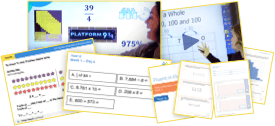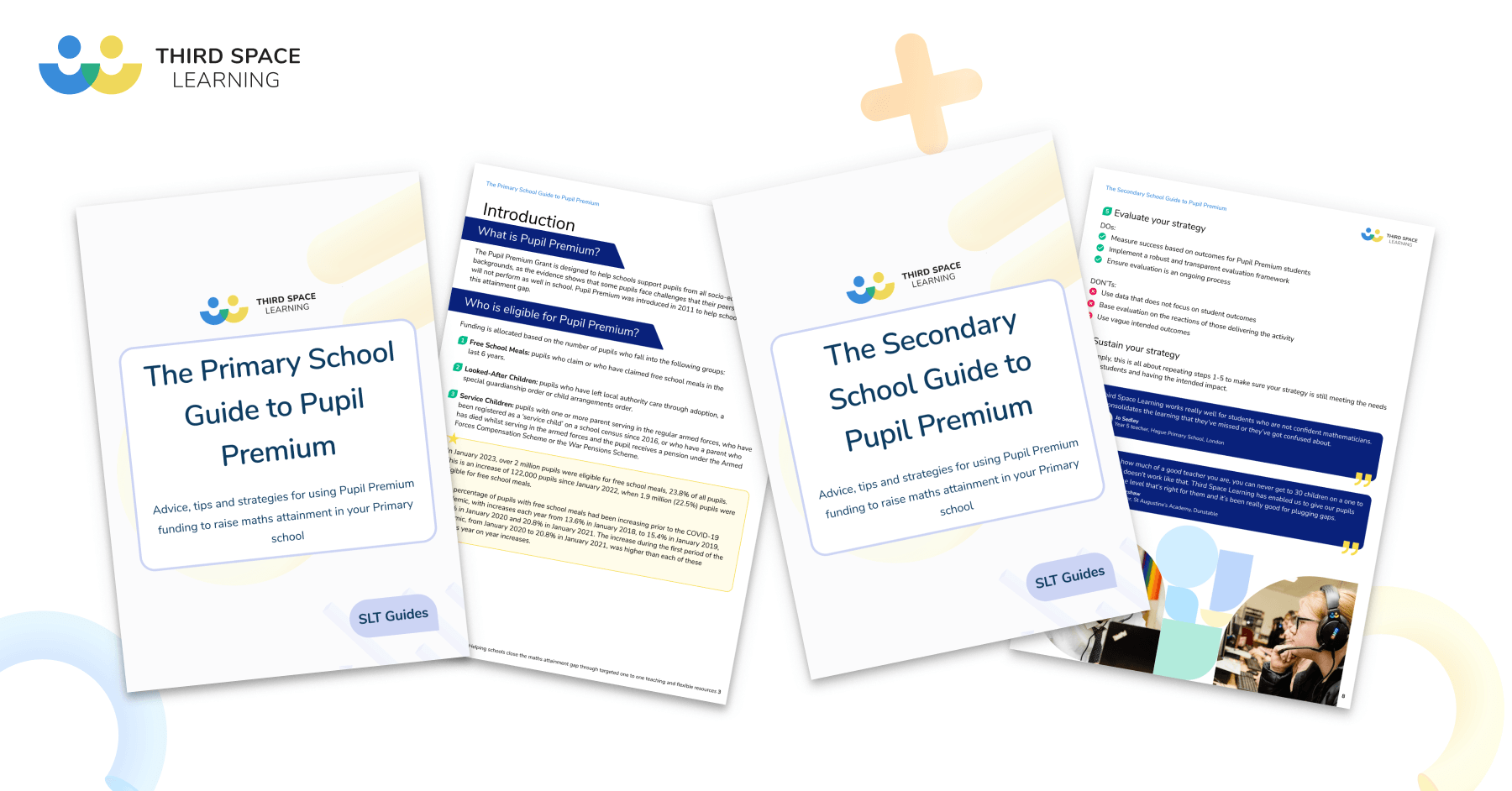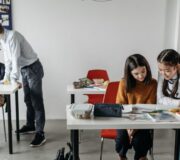45 Pupil Premium Strategies For Cost Effective Impact In Primary Schools 2024
This article summarises the best research into pupil premium strategies that work. Much of this research is from the EEF Toolkit as well as from former pupil premium award winners to bring you what we believe are the best pupil premium strategies that primary school leaders should be looking at.
For many primary schools and secondary schools, because of the area they serve, pupil premium funding forms a sizeable chunk of the overall school budget.
With this comes accountability, schools must create a pupil premium strategy statement to report on how they spend their pupil premium and any pupil premium strategies or interventions they introduce are as effective as possible.
To have as wide a reach as possible, a menu of approaches that are free or very low cost, but also highly effective is ideal.
The Senior Leader's Guide to the Pupil Premium
An informative and concise guide on making the best choices for all the children in your care [UPDATED FOR 2023/24]
Download Free Now!What is pupil premium?
Pupil premium is money given to schools to help them support disadvantaged pupils. It is a government scheme, introduced in 2011, and aims to provide schools with resources to improve the outcomes of underprivileged 5-16 year olds in state-funded schools in England.
What is pupil premium 2023/24?
Pupil premium funding 2023/24 increased by 5% from the 2022/23 academic year.
For the 2023/24 academic year, primary schools will receive £1,480 per eligible child and secondary schools will receive £1,050 in 2023/34. Looked after children qualify for £2,570 of pupil premium funding, regardless of whether at a primary or secondary school.
Tutoring Funding Summary: Downloadable guide for SLT
Tutoring Funding Calculator – see exactly how much funding your school will receive in 2024/25:
Who qualifies for pupil premium funding?
Children eligible for pupil premium in 2023/24 are those who:
- Are eligible for free school meals or have been eligible in the previous six years
- Have been looked after, or are covered by a guardianship or residency order
- Have been adopted from care
- Have a parent serving in the armed forces
How to effectively spend pupil premium funding: for primary and secondary schools
This post reviews the best and latest information available on how to most effectively spend your pupil premium funding for primary schools and secondary schools. While the majority of strategies are suitable for both, some strategies may apply to primary or secondary only.
Included are a 15-point success plan, pupil premium intervention ideas and an Ofsted checklist to ensure you’re implementing pupil premium effectively with the evidence to back it up.
And a bonus section on pupil premium plus pupils detailing how to effectively support these children within your budget.
Hopefully, this information provides headteachers and school leaders with clear guidelines to use when mapping out their own pupil premium strategy for 2023/24.
For more information about pupil premium funding, read the pupil premium guide for primary school leaders.
Accountability to Ofsted of pupil premium spending
Ofsted inspectors don’t judge a school solely on pupil premium funding spending. They need to see evidence of the pupil premium strategy statement to see that the money is used for effective pupil premium strategies and initiatives.
They will also look for evidence that the school’s leadership is monitoring and managing pupil premium spending to help close the attainment gap.
What effective use of the pupil premium looks like can be difficult to gauge. What works in one school, or with one set of pupils, may not necessarily work with another.
It can be challenging for heads and teachers to decide which strategies to use for the speediest results.
Sometimes these initiatives or intervention strategies take time to show results even if, in the long run, they prove to be successful.
Read more: Ofsted & Pupil Premium Accountability
The Senior Leader's Guide to the Pupil Premium
An informative and concise guide on making the best choices for all the children in your care [UPDATED FOR 2023/24]
Download Free Now!Your 15-point pupil premium success plan
Sir John Dunford, former National Pupil Premium Champion, spent 2 years examining the most successful pupil premium strategies. He spoke to schools and acted as a channel of communication between the Department for Education and schools.
He noted the most successful schools used a menu of approaches targeted to the needs of individual pupils rather than sticking with one or two strategies.
The most successful schools:
1. Collected and analysed data on groups and individual pupils, and monitored this over time
2. Focused on teaching quality
3. Identified the main barriers to learning for disadvantaged children
4. Put interventions in place when progress has slowed
5. Engaged with parents and carers in the education of their child
6. Referred to existing evidence about the effectiveness of different strategies
7. Trained all classroom staff in the school strategies
8. Secured staff commitment to the importance of the pupil premium agenda
9. Trained governors on pupil premium
In deciding which policies to use, heads and teachers needed to:
10. Decide what the school wants to achieve with Pupil Premium funding
11. Analyse the barriers to learning before deciding what strategies to use
12. Decide on desired outcomes and identify success criteria for each
13. Monitor and evaluate the impact of any current strategies on pupils; change them if they’re not working
14. Decide on an optimum range of approaches to use
15. Keep up to date with research
Sir John said: “In future, it will be up to regional school commissioners, local authorities, multi-academy trusts and school alliances to keep the pupil premium cause at the top of their list of priorities. The social, moral and educational case for giving additional support to children born less fortunate than others remains as strong as ever. Every school needs a Pupil Premium Champion.”
Case Study: Pakeman Primary School, National Pupil Premium Award Winner
It’s no surprise to Lynne Gavin that one-to one tuition is one of the most effective means of using Pupil Premium funding. In her own school Pakeman Primary School in Islington, north London, nearly 50 Year 6 pupils are targeted for individual teaching in Mathematics, using expert tutors from Third Space Learning. They use pupil premium funding to pay for the interventions.
Find out more about the strategies Pakeman Primary used when they won the Pupil Premium Awards 2013.
“We identified children who had specific gaps to enable them to make accelerated progress,” Ms Gavin, the headteacher of Pakeman, said. “The pupils enjoy it because not only is it one-to-one learning, which helps to build their self-esteem and confidence as well as plug those gaps in knowledge, but it uses technology, which they love and feel comfortable with.”
Currently about 77% of pupils at Pakeman are eligible for free school meals and receive pupil premium funding. This has dropped from 86% three years ago as government benefit cuts have redefined poverty. “If anything, the poverty levels in the school are higher now than then, so offering pupils support such as individual tuition is incredibly important,” she said.
In 2013, Pakeman was the national primary winner in the Pupil Premium Awards for raising the attainment of its disadvantaged children using a host of strategies and approaches. Ms Gavin is thrilled with the impact of the interactive one-to-one tutorials on her pupils.
“Third Space Learning knows how to tailor the learning to meet the needs of each child. The tutors are in India [and Sri Lanka] so the children love the fact they can interact with people so far away, it broadens their experience of life generally,” Ms Gavin added. “We have been thrilled with the impact for pupil premium that this one-to-one tuition has had on the pupils.”
The one to one tutoring that Pakeman Primary first gave their pupils in 2013 has now supported roughly 60,000 pupils in receipt of pupil premium funding to improve their maths outcomes. Request a quote now to find out how it could work for your pupils.
The one to one tutoring that Pakeman Primary introduced to their pupils in 2013 has now supported over 190,000 pupils to help close the maths attainment gap — the majority in receipt of pupil premium funding.
Request a quote today to find out how Third Space Learning’s personalised one-to-one maths interventions can help boost maths progress in your school.
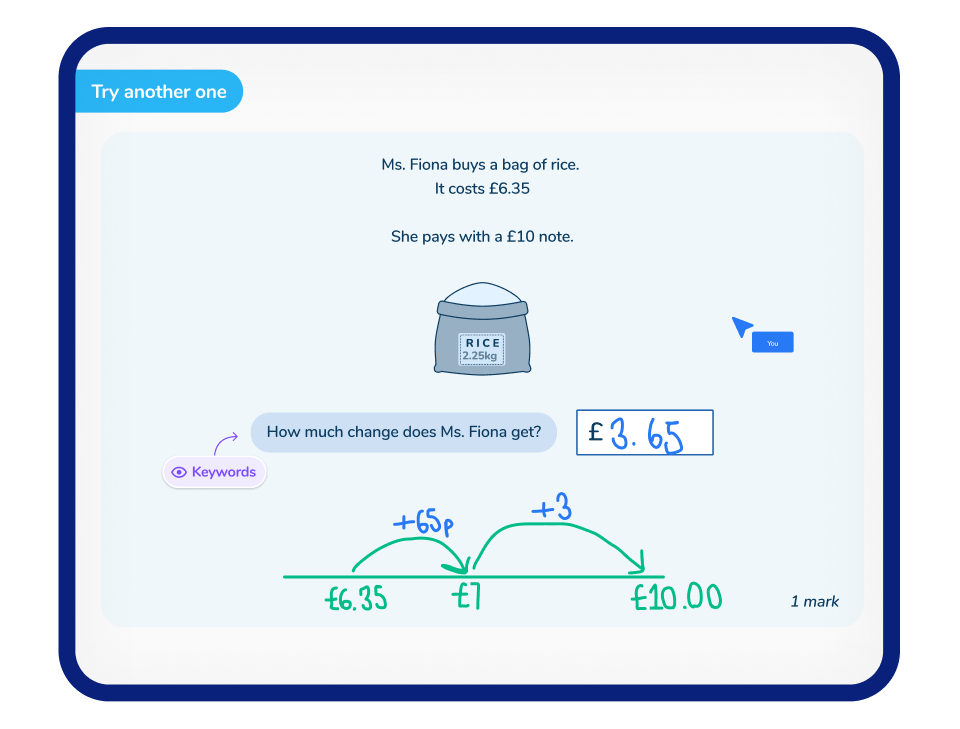
One-to-one SATs Revision Programme session
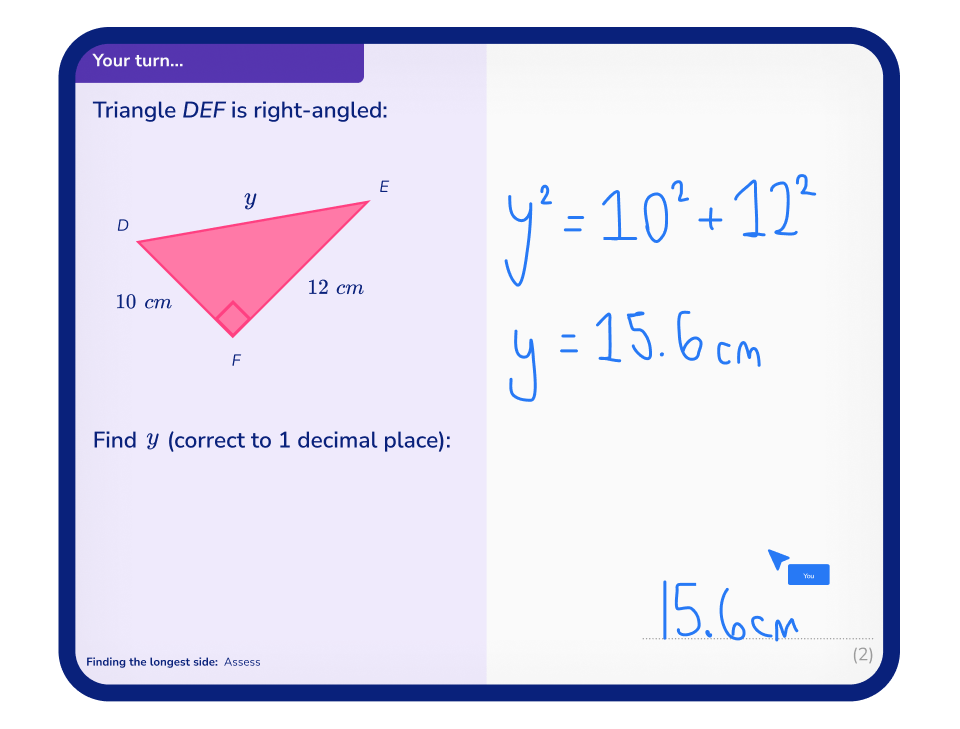
One-to-one GCSE Revision Programme session
Evidence the impact of your pupil premium interventions
Pupils’ needs vary and not all pupil premium interventions will have the same impact in all primary and secondary schools.
But thanks to the work from The Educational Endowment Foundation and the Sutton Trust on their Teaching and Learning Toolkit there is now robust evidence of intervention effectiveness.
The EEF monitor schools’ best practices and have produced the Teaching and Learning Toolkit for schools which is regularly updated.
This lists 10 strategies most commonly used by primary and secondary schools, how cost-efficient these are and how much progress learners made using these strategies over 12 months.
Regular reports are added to the EEF website. One report demonstrated that primary schools offering pupils a free and nutritious meal at breakfast clubs boosted their reading, writing and Maths by the equivalent of two months’ progress over a year. All for very little cost.
20 most effective pupil premium strategies for primary schools and secondary schools
1) Feedback
Cost: Low
Progress: 8+ months
Feedback for pupils can be verbal or written. It helps to inform learners about their performance and progress relative to learning objectives or outcomes. Feedback aims to aid and improve pupil learning by redirecting or refocusing the teacher’s or learner’s actions to achieve a goal.
Read more: How Diagnostic Assessment Improves Maths Teaching
2) Metacognition and self-regulation
Cost: Low
Progress: 8+ months
Metacognition and self-regulation help pupils think more explicitly about their learning. To achieve metacognition in a classroom, educators can teach pupils a variety of specific strategies to set targets and monitor and evaluate their academic development. Self-regulation relies on the learner managing their intrinsic motivation towards learning.
3) Reading comprehension strategies
Cost: Low
Progress: 5+ months
Comprehension strategies aim to improve reading by focusing on the understanding of text. Techniques to improve reading comprehension include:
- Inferring the meaning from context
- Summarising or identifying key points
- Using graphic or semantic organisers
- Questioning strategies
- Learners monitoring their comprehension and identifying difficulties
Research has found reading comprehension strategies particularly effective with children aged 8+ who are behind with their reading.
4) Mastery learning
Cost: Low
Progress: 5+ months
Mastery learning involves breaking a subject and learning content down into units to achieve the specified learning objectives. Learners work through each block of content in a series of sequential steps and must achieve a level of success, measured through testing, before progressing to new content. Students who do not reach the required level are typically provided with additional tuition, peer support, small group discussions, or homework so that they can reach the expected level.
Read this: Maths Mastery Toolkit: A Practical Guide To Mastery Teaching And Learning
5) Collaborative learning
Cost: Low
Progress: 5+ months
Collaborative or cooperative learning involves teachers setting tasks or activities where students work together in small groups. Each participant should have an equal opportunity to contribute. Tasks can be either joint where group members complete different aspects of the task but contribute to a common overall outcome, or a shared task where group members work together throughout the activity.
The most effective collaborative approaches are those which promote interaction between group members.
6) Early years interventions [primary school]
Cost: Very high
Progress: 5+ months
These aim to ensure that children have the educational pre-school or nursery experiences that prepare them for the rest of their school lives. These include multi-component programmes of provision and focus on disadvantaged children. Some also offer parental support.
To be effective, well-qualified and well-trained staff are essential, these interventions take place over a longer period (more than a year) and include a mixture of children from different social backgrounds, as well as a strong educational component.
7) One-to-one tuition
Cost: High
Progress: 5+ months
During one-to-one tuition, a teacher, teaching assistant or other educator provides a pupil with intensive individual support.
Often, one-to-one learning takes place outside of the lesson time so pupils still receive high quality teaching in class. Evidence-based research suggests that one-to-one interventions should be additional to, but explicitly linked with, whole-class teaching and learning.
Guidance reports indicate that short but regular sessions of about 30 minutes 3-5 times a week over a set period, such as 6-12 weeks, are optimal.
Read this: KS2 Maths Interventions Using Personalised One To One Tuition
8) Oral language interventions
Cost: Low
Progress: 5+ months
Oral language interventions emphasise spoken language and verbal interaction in the classroom so that learners benefit from explicit discussion of content, the processes of learning, or both.
Approaches include:
- Targeted reading aloud and discussing books with young children
- Explicitly extending pupils’ spoken vocabulary
- Structured questioning to develop reading comprehension
9) Peer tutoring
Cost: Low
Progress: 5+ months
Unlike one-to-one tutoring, peer tutoring involves pupils working in pairs or small groups to offer each other support.
Sometimes, this can take place as cross-age tutoring, where an older learner takes the tutoring role and is paired with a younger tutee or tutees.
Reciprocal peer tutoring alternates the learners’ roles of tutor and tutee.
The key characteristic of these approaches is that learners take on responsibility for aspects of teaching and evaluating their success.
10) Phonics [primary school]
Cost: Very low
Progress: 4+ months
Phonics is the teaching of reading which develops learners’ phonetic awareness. It aims to teach learners the relationship between sounds (phonemes) and the spelling patterns of letters (graphemes) which represent them. Children learn to read by segmenting and then blending words.
Children should be competent in phonics by 6 years old and sit a test at the end of Year 1 to assess their phonics. However, in some cases, children will need interventions and high-quality teaching on phonics beyond the end of Key Stage 1.
Conside phonics teaching in all aspects of reading, including vocabulary, comprehension and spelling.
11) Outdoor adventure learning
Cost: Moderate
Progress: 4+ months
Adventure learning typically involves the development of skills through outdoor experiences such as climbing and assault courses, or outdoor sports such as sailing and canoeing. Outdoor adventure learning requires well-trained, qualified staff.
This type of intervention does not usually include a formal academic element. Although, studies show these interventions can have positive benefits on learning, particularly for more vulnerable pupils and teenagers.
Research suggests these types of interventions appear to be most effective when they are longer in duration, such as a week at a time. They can contribute to positive impacts on self-confidence, self-efficacy and motivation.
Here is a comprehensive list of 13 outdoor maths activities to give you some further ideas on how to integrate outdoor learning into your curriculum.
12) Small group tuition
Cost: Moderate
Progress: 4+ months
Small group tuition involves a teacher or teaching assistant working with a group of pupils, usually up to five pupils. Often, this takes place in a separate classroom or working area.
Generally, small group tuition supports lower-attaining learners or those falling behind. However, pupils at all levels can benefit from this targeted approach.
It can also ensure effective progress or help teach challenging topics or skills.
13) Digital technology
Cost: Moderate
Progress: 4+ months
Using digital technology to support learners can be highly effective in academic support. Teachers can use digital technology, for example, an interactive whiteboard. Pupils can use digital technology, for example, software programmes to aid learning.
Although evidence-based research for digital technology has concluded mixed results for its effectiveness it does suggest that these approaches are most beneficial for writing and maths.
Ultimately, it is the teaching and learning objectives rather than the specific technology that is important here. Teachers may also require cpd support to use new digital technology in the classroom.
Read more: How To Do A School Technology Audit
14) Social and emotional learning (SEL)
Cost: Moderate
Progress: 4+ months
Targeting the SEL needs of pupils aims to improve their interaction with others and their management of emotions rather than specifically academic goals.
SEL initiatives may present themselves as well-being programmes in the classroom, specialised programmes targeted at particular students or wider school approaches.
Again, teachers may require professional development training to implement social and emotional interventions for pupils.
15) Behaviour interventions
Cost: Moderate
Progress: 3+ months
Behaviour interventions seek to improve pupil outcomes by reducing both low-level disruption and challenging behaviour, including aggression, violence and general anti-social activities.
Strategies may include a whole-school ethos that seeks to improve behaviour in the classroom or specialised programmes and initiatives for individual pupils with specific behavioural needs.
It is difficult to quantify the impact as there is variation in the evidence. This suggests that schools should look for programmes with a proven track record.
16) Parental engagement
Cost: Moderate
Progress: 3+ months
Involving parents in education improves pupil outcomes. Encouraging parental engagement may include workshops to improve literacy or IT skills, general approaches such as encouraging parents to read with their children as well as more intensive programmes for identified families.
Studies suggest that parental engagement is easier in primary schools than in secondary schools. One low-cost evidence-based method for boosting parental engagement is contact from schools via text-message alerts.
Read: How to Increase Parental Engagement in Primary Maths
17) Attainment setting
Cost: Very low
Progress: 3+ months
Particularly in secondary schools, pupils are set or streamed according to attainment for specific subjects. In Key Stage 3 and Key Stage 4 pupils often separate into different classrooms.
In primary schools, it can prove trickier and less common to set pupils by attainment.
Using attainment to structure lessons ensures pupils’ tasks and challenges are tailored to their abilities.
There is much debate over mixed ability vs ability grouping. While beneficial for high-attainers, setting for lower-attaining pupils can have negative consequences on mindset. It can be a difficult task for teachers to set pupils without creating a fixed mindset.
18) Individualised instruction
Cost: Very low
Progress: 3+ months
Individualised instruction can be difficult to execute with so many varying abilities in one class. Often, teachers will pitch whole-class high-quality teaching to meet a wide variety of pupil needs.
Independent work is individualised and differentiated according to the class’ abilities.
This low threshold, high ceiling approach can be very effective when done correctly. However, planning for individualised instruction can be difficult and take a lot of time.
Some may use digital programmes for individualised support, but educators need to be aware of the pedagogical approaches behind the instruction.
19) Reducing class size
Cost: High
Progress: 3+ months
Evidence-based research suggests that as class sizes reduce, the amount of time a teacher can spend with an individual, as well as the range of approaches they can try, increases.
While this seems obvious, the evidence does not show a particularly large or clear effect until class size reduces to fewer than 20 pupils.
There is some evidence that smaller classes have a positive impact on lower attainers, disadvantaged children and very young pupils.
20) Summer Schools
Cost: Moderate
Progress: 2-4+ months
Over the summer holidays, pupils may experience learning loss. Lessons during the summer holidays can have a positive impact on pupil’s progress, especially if the summer school has clear learning aims and small-group teaching.
Extensive evidence is available on summer school effectiveness, across primary and secondary school. Some studies indicate greater gains for disadvantaged pupils through summer school, but this is inconsistent.
Read more: The most effective intervention strategies for schools
4-step Pupil Premium Checklist for Ofsted
Effective use of Pupil Premium funding is now part of the Ofsted accountability process. Inspectors require schools to evidence their pupil premium strategy and its impact on pupils progress.
4 key Ofsted recommendations are:
1. Detail the pupil premium strategy on the school website and provide information about how they plan to narrow the attainment gap
2. Provide information detailing the amount of pupil premium funding received by the school during the current and previous academic year
3. Evidence of how the school spends the pupil premium funding and how they make spending decisions
4. Demonstrate the impact on the learning and progress of eligible pupils using outcomes data
Judgement of the school’s leadership and management is based on how well they spend their pupil premium funding along with the rest of their budget and measure the impact on pupil outcomes.
Governors must demonstrate that they challenge the senior leadership team on the variations in achievement between different groups. They should show what they are doing to address these.
The effectiveness of governors challenging SLT on pupil premium spending could affect a school’s leadership and management Ofsted gradings.
Inspectors can call for an external review of the school’s pupil premium spending if they identify specific issues relating to the provision and outcomes for disadvantaged pupils.
More on Ofsted: Why you shouldn’t aim for Ofsted outstanding
What is pupil premium plus?
In 2013 The DfE introduced pupil premium plus funding for state-funded school.
Pupil Premium Plus is available to pupils in England from reception age to Year 11 who:
- Are looked after in local authority care in England.
- Have been adopted from care in England or Wales.
- Left care under a Special Guardianship Order (SGO).
- Left care under a Child Arrangements Order (formerly known as a Residence Order)
Initially, only children adopted on or after 30th December 2005 received pupil premium plus. But in the summer of 2014, it extended to all children adopted from care.
Wider strategies for pupil premium plus
Given the complex and multiple needs that pupils who have been under local authority care may have, there are different considerations for schools in receipt of pupil premium plus allocation.
In some cases, it is necessary to consider pupil outcomes beyond their education outcomes.
In particular, children may struggle with:
- Attachment relationships with adults
- Managing their peer relationships
- Managing their feelings and behaviour
- Coping with transitions
- Developing their executive functioning skills
Schools receiving pupil premium plus funding may look to PAC-UK for further spending advice.
If children are still within the care of the local authority, many of these recommendations may also form part of their Individual Education Plan (IEP) and the local authority virtual school will support them.
6 pupil premium plus strategies
- Provide nurturing and relationships, for example through a nurture group, and train staff to provide key attachment relationships.
- Scaffold children’s social skills and peer relationships, for example through lunchtime clubs, with opportunities to practice social skills or facilitate friendships e.g. buddy schemes and peer mentoring initiatives.
- Develop emotional literacy and emotion regulation through group work, zones of regulation, or some calm zones in classrooms and centrally within the school.
- Support children with transitions such as preparing for the Year 6 transition to Year 7 to give them the best start to secondary school ahead of GCSEs. Schools may provide support for changes, for example, additional structure during break and lunchtimes and offering safe spaces for children to come to throughout the school day.
- Develop children’s executive functioning skills for example through training staff in understanding and supporting executive functioning skill development in the classroom and on the playground and providing coaching for those who struggle to plan and organise.
- Address barriers to information sharing and joint working by identifying a named member of staff who liaises with the parents or guardians and facilitates regular meetings to discuss the child’s needs and progress.
Which pupil premium strategies suit your 2023/24 cohort?
Hopefully, the information provided has given you a clearer idea of the pupil premium strategies that will have the biggest impact and help you make the best decisions with your budget for 2023/24
You can find a further 10 low cost pupil premium intervention ideas to help inform your pupil premium spending.
DO YOU HAVE STUDENTS WHO NEED MORE SUPPORT IN MATHS?
Every week Third Space Learning’s maths specialist tutors support thousands of students across hundreds of schools with weekly one to one tuition designed to plug gaps and boost progress.
Since 2013 these personalised one to one lessons have helped over 150,000 primary and secondary students become more confident, able mathematicians.
Learn how the tutoring benefits those in receipt of pupil premium or request a personalised quote for your school to speak to us about your school’s needs and how we can help.
